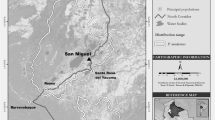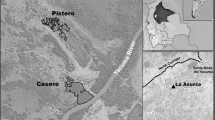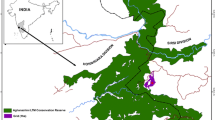Abstract
We observed a unimale group (BE-Group) of proboscis monkeys (Nasalis larvatus) comprising an α-male, 6 adult females, and several immatures from May 2005 to May 2006. We followed the group for 2014 h along the Menanggul River, Sabah, Malaysia (118°30′E, 5°30′N). Observations focused mainly on ranging behavior. We determined availability and seasonal changes in plant species consumed by the members of the group by vegetation surveys in a 2.15-ha area along 200–500 m trails in the riverine forest. During the observation period, the group ranged ≤800 m from the riverbank, within a total range of 138.3 ha. The daily path length of the group ranged from 220 to 1734 m (mean, 799 m), and daily path length correlates negatively with fruit availability. The monkeys were apt to remain within a small range in fruit-abundant seasons. Because the monkeys preferred to feed on fruits of dominant plant species in the study area, their daily path length may decrease on days when they feed on fruits. The core areas of the group’s home range were along the river because the monkeys typically returned to riverside trees to sleep. The group most often used areas that were nearer the riverbank and where the availability of fruits was higher. The most frequently used grids were the ones where the group often had sleeping sites and crossed the river. Avoiding predation may be the main reason for river crossing and selecting particular sleeping sites; hence not only food availability but also the risk of predation appears to influence the ranging of the BE-Group.





Similar content being viewed by others
References
Agetsuma, N. (1995). Foraging strategies of Yakushima macaques (Macaca fuscata yakuni). International Journal of Primatology, 16, 595–609. doi:10.1007/BF02735283.
Agetsuma, N., & Noma, N. (1995). Rapid shifting of foraging pattern by Yakushima macaques (Macaca fuscata yakuni) as a reaction to heavy fruiting of Myrica rubra. International Journal of Primatology, 16, 247–260. doi:10.1007/BF02735480.
Bennett, E. L. (1986). Environmental correlates of ranging behaviour in the banded langur, Presbytis melalophus. Folia Primatologica, 47, 26–38. doi:10.1159/000156261.
Bennett, E. L., & Davies, A. G. (1994). The ecology of Asian colobines. In A. G. Davies, & J. F. Oates (Eds.), Colobine Monkeys: Their Ecology, Behaviour and Evolution. Cambridge, UK: Cambridge University Press.
Boonratana, R. (1993). The Ecology and Behaviour of the Proboscis Monkey (Nasalis larvatus) in the Lower Kinabatangan, Sabah. PhD Thesis. Faculty of Graduate Studies, Mahidol University
Boonratana, R. (2000). Ranging behavior of proboscis monkeys (Nasalis larvatus) in the lower Kinabatangan, Northern Borneo. International Journal of Primatology, 21, 497–518. doi:10.1023/A:1005496004129.
Cheney, D. L., & Wrangham, R. W. (1987). Predation. In B. B. Smuts, D. L. Cheney, R. M. Seyfarth, R. W. Wrangham, & T. T. Struhsaker (Eds.), Primate Societies (pp. 227–239). Chicago: University of Chicago Press.
Clutton-Brock, T. H. (1975). Ranging behaviour of red colobus (Colobus badius tephrosceles), in the Gombe National Park. Animal Behaviour, 23, 706–722. doi:10.1016/0003-3472(75)90147-5.
Coelho, A. M., Bramblett, C. A., Quick, L. B., & Bramblett, S. S. (1976). Resource availability and population density in primates: A socio-bioenergetic analysis of the energy budges of Guatemalan howler and spider monkeys. Primates, 17, 63–80. doi:10.1007/BF02381567.
Crook, J. H., & Aldrich-Blake, F. P. G. (1968). Ecological and behavioural contrasts between sympatric ground dwelling primates in Ethiopia. Folia Primatologica, 8, 192–227. doi:10.1159/000155154.
Di Fiore, A. (2003). Ranging behavior and foraging ecology of lowland woolly monkeys (Lagothrix lagotricha poeppigii) in Yasuní National Park, Ecuador. American Journal of Primatology, 59, 47–66. doi:10.1002/ajp.10065.
Estrada, A. (1984). Resource use by howler monkeys (Alouatta pallitat) in the rain forest of Los Tuxtlas, Veracruz, Mexico. International Journal of Primatology, 5, 105–131. doi:10.1007/BF02735736.
Fashing, P. J. (2007). African colobine monkeys: Patterns of between-group interaction. In C. J. Campbell, A. Fuentes, K. C. Mackinnon, M. Panger, & S. K. Bearder (Eds.), Primates in Perspective (pp. 201–224). New York: Oxford University Press.
Johnson, B. J., & Omland, K. S. (2004). Model selection in ecology and evolution. Trends in Ecology & Evolution, 19, 101–108. doi:10.1016/j.tree.2003.10.013.
Kirkpatrick, R. C. (2007). The Asian colobines diversity among leaf-eating monkeys. In C. J. Campbell, A. Fuentes, K. C. Mackinnon, M. Panger, & S. K. Bearder (Eds.), Primates in Perspective (pp. 186–200). New York: Oxford University Press.
Koenig, A. (2000). Competitive regimes in forest-dwelling Hanuman langur females (Semnopithecus entellus). Behavioral Ecology and Sociobiology, 48, 93–109. doi:10.1007/s002650000198.
Lambert, J. E. (2007). Primate nutritional ecology. Feeding biology and diet at ecological and evolutional scales. In C. J. Campbell, A. Fuentes, K. C. Mackinnon, M. Panger, & S. K. Bearder (Eds.), Primates in Perspective (pp. 482–495). New York: Oxford University Press.
Makey, D., & Waterman, P. G. (1982). Ranging behaviour of a group of black colobus (Colobus satanas) in the Douadla-Edea Reserve, Cameroon. Folia Primatologica, 39, 264–304. doi:10.1159/000156081.
Marsh, C. W. (1981). Time budget of Tana River red colobus. Folia Primatologica, 35, 30–50. doi:10.1159/000155964.
Matsuda, I. (2008). Feeding and Ranging Behaviors of Proboscis Monkey Nasalis larvatus in Sabah, Malaysia. Ph.D. thesis, Graduate School of Environmental Earth Science, Hokkaido University.
Matsuda, I., Tuuga, A., & Higashi, S. (2008a). Clouded Leopard (Neofelis diardi) Predation on Proboscis Monkeys (Nasalis larvatus) in Sabah, Malaysia. Primates, 49, 65–68. doi:10.1007/s10329-007-0042-5.
Matsuda, I., Tuuga, A., Akiyama, Y., & Higashi, S. (2008b). Selection of River Crossing Location and Sleeping Site by Proboscis Monkeys (Nasalis larvatus) in Sabah, Malaysia. American Journal of Primatology, 70, 1097–1101. doi:10.1002/ajp.20604.
Matsuda, I., Tuuga, A., & Higashi, S. (in press). The feeding ecology and activity budget of proboscis monkeys. American Journal of Primatology.
Miller, L. E., & Treves, A. (2007). Predation on primates. In C. J. Campbell, A. Fuentes, K. C. Mackinnon, M. Panger, & S. K. Bearder (Eds.), Primates in Perspective (pp. 525–543). New York: Oxford University Press.
Mitani, J. C., & Rodman, P. S. (1979). Territoriality: The relation of ranging patterns and home range size to defensibility, with an analysis of territoriality among primate species. Behavioral Ecology and Sociobiology, 5, 241–251. doi:10.1007/BF00293673.
Napier, P. H. (1985). Catalogue of Primates in the British Museum (Natural History) and Elsewhere in the Subfamily Colobinae. London: British Museum (Natural History).
Napier, J., & Napier, P. (1985). The Natural History of the Primates (p. 158). Cambridge, MA: MIT Press.
Newton, P. N. (1992). Feeding and ranging patterns of forest hanuman langurs (Presbytis entellus). International Journal of Primatology, 13, 245–285. doi:10.1007/BF02547816.
Nunes, A. (1996). Foraging and ranging in white-bellied spider monkeys. Folia Primatologica, 65, 85–99.
Oates, J. F. (1987). Food distribution and foraging behavior. In B. B. Smuts, D. L. Cheney, R. M. Seyfarth, R. W. Wrangham, & T. T. Struhsaker (Eds.), Primate Societies (pp. 197–209). Chicago: University of Chicago Press.
Olupot, W., Chapman, C. A., Brown, C. H., & Waser, P. M. (1994). Mangabey (Cercocebus albigena) population density, group size, and ranging: A twenty year comparison. American Journal of Primatology, 32, 197–205. doi:10.1002/ajp.1350320306.
R Development Core Team. (2007). R: A language and environment for statistical computing. Vienna: R Foundation for Statistical Computing
Raemaekers, J. (1980). Causes of variation between months in the distance traveled daily by gibbons. Folia Primatologica, 34, 46–60.
Schultz, A. H. (1942). Growth and development of the proboscis monkey. Bulletin of the Museum of Comparative Zoology (Harvard), 89, 279–314.
Stanford, C. B. (1991). The Capped Langur in Bangladesh: Behavioral Ecology and reproductive tactics. New York: Karger.
Stevenson, P. R., Quinones, M. J., & Ahumada, J. A. (1994). Ecological strategies of wooly monkeys. American Journal of Primatology, 32, 123–140. doi:10.1002/ajp.1350320205.
Struhsaker, T. T., & Leland, L. (1987). Colobines: Infanticide by adult males. In B. B. Smuts, D. L. Cheney, R. M. Seyfarth, R. W. Wrangham, & T. T. Struhsaker (Eds.), Primate Societies (pp. 83–97). Chicago: University of Chicago Press.
Tenaza, R. R. (1975). Territory and monogamy among Kloss’ gibbons (Hylobates klossii) in Siberut Island, Indonesia. Folia Primatologica, 24, 60–80. doi:10.1159/000155685.
Terborgh, J. (1983). Five New World Primates: A Study in Comparative Ecology. Princeton, NJ: Princeton University Press.
Waterman, P. G. (1984). Food acquision and processing as a function of plant chemistry. In D. J. Chivers, B. A. Wood, & A. Bilsborough (Eds.), Food Acquisition and Procession in Primates (pp. 177–211). New York: Plenum Press.
Yeager, C. P. (1989). Feeding ecology of the proboscis monkey (Nasalis larvatus). International Journal of Primatology, 10, 497–530. doi:10.1007/BF02739363.
Yeager, C. P. (1991). Possible antipredator behavior associated with river crossings by proboscis monkeys (Nasalis larvatus). American Journal of Primatology, 24, 61–66. doi:10.1002/ajp.1350240107.
Acknowledgments
We thank the Economic Planning Unit of the Malaysian Government, especially M. Bt. A. Manan and G. Vu, for permission to conduct our research in Malaysia. We particularly thank the staff of the Sabah Wildlife Department for their permission to conduct our research in Lower Kinabatangan Wildlife Sanctuary. We also thank the staff of Forestry Department, Sabah, especially Haji H. Tukiman, L. Ruki, J. Sugau, J. T. Pereira, and P. Miun, for arranging our base camp and supporting the identification of all plants species. We thank I. Lackman-Ancrenaz, M. Ancrenaz, Z. A. Jaffer, A. B. Etin, and all members of the Kinabatangan Orangutan Conservation Project for their help. We thank our research assistants, especially A. Bin Arsih and M. S. Bin A. Karim, for their support. N. Agetsuma, Y. Akiyama, G. Hanya, T. Ikeda, T. Iwakuma, K. Watanabe, and J. Yamagiwa generously supplied advice and support. We truly appreciate Y. Katsuta for supporting our research. Lastly, thank anonymous reviewers for their fruitful comments that improved this manuscript.
Author information
Authors and Affiliations
Corresponding author
Rights and permissions
About this article
Cite this article
Matsuda, I., Tuuga, A. & Higashi, S. Ranging Behavior of Proboscis Monkeys in a Riverine Forest with Special Reference to Ranging in Inland Forest. Int J Primatol 30, 313–325 (2009). https://doi.org/10.1007/s10764-009-9344-3
Received:
Accepted:
Published:
Issue Date:
DOI: https://doi.org/10.1007/s10764-009-9344-3




